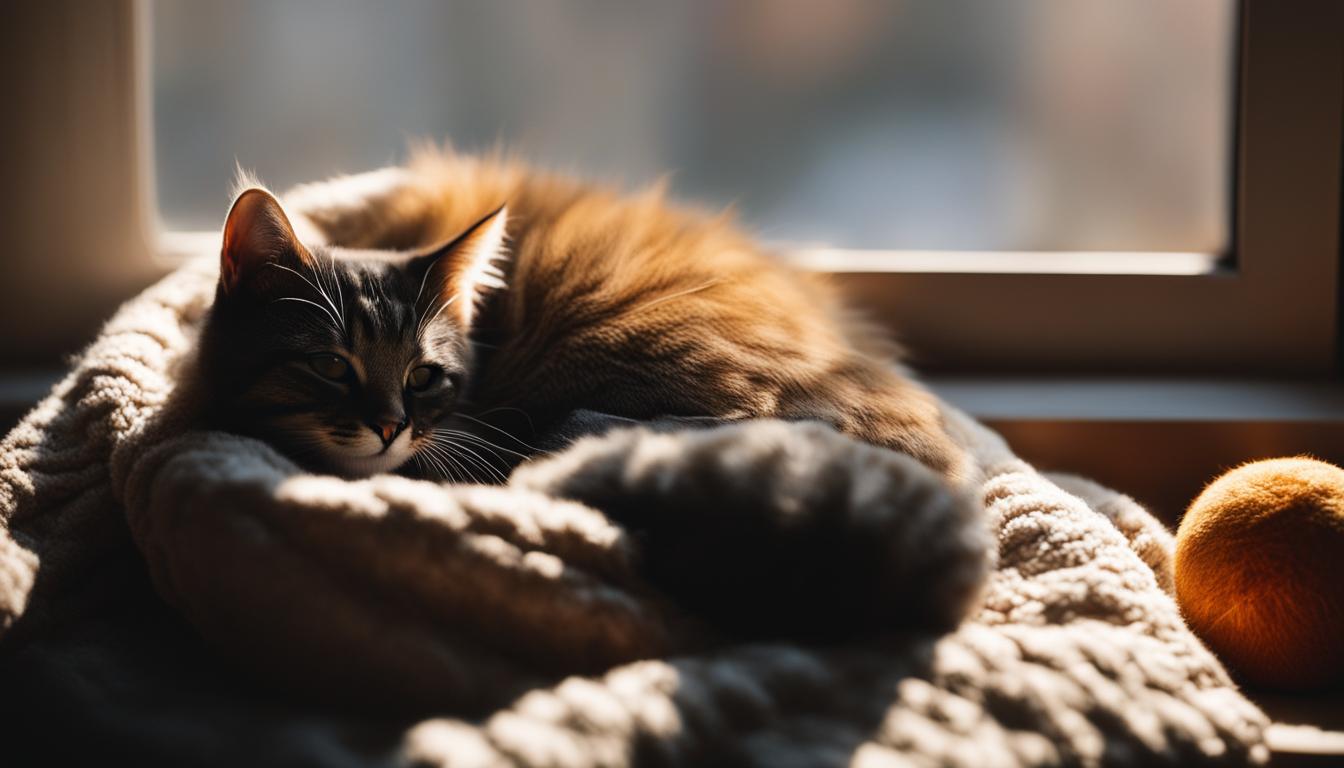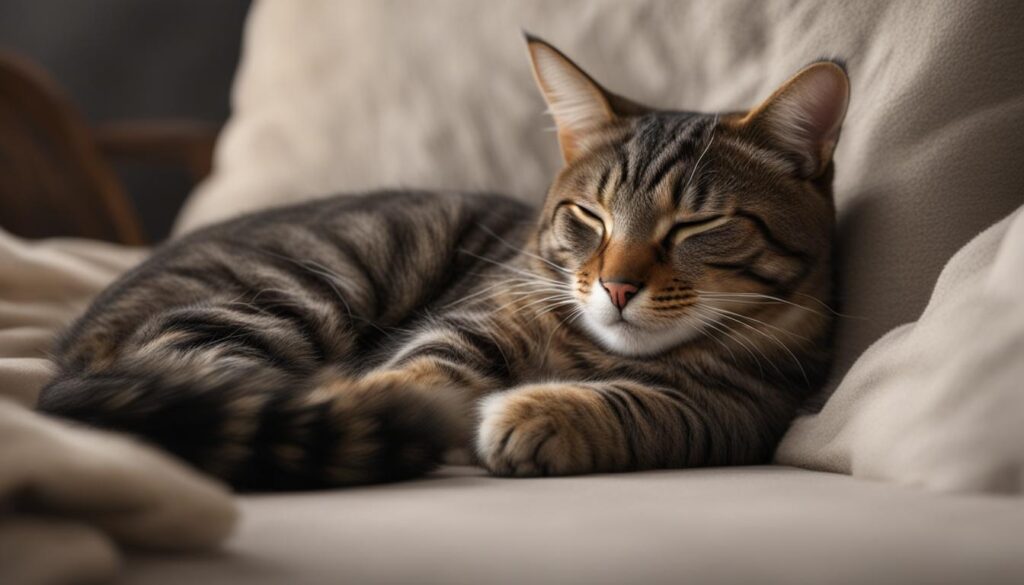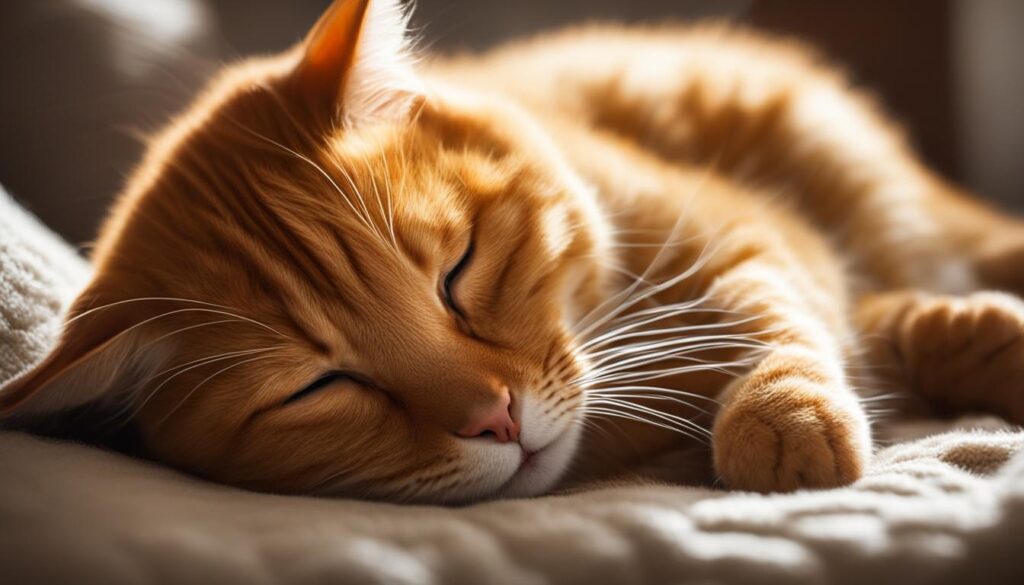Unraveling the mystery: Why do cats sleep in a ball?
As a cat lover, I’ve often wondered why our feline friends love to sleep curled up in a ball. It’s a common sight – a cat tucked into a tight ball, with their legs and tail wrapped around them. But what is the reason behind this adorable sleep position? Let’s dive into the fascinating world of cat sleep behavior and discover why cats choose to sleep in a ball.
When it comes to cat sleeping habits, there are several factors at play. Cats instinctively seek out warmth, security, and relaxation in their sleep positions. The curled-up position helps them conserve body heat and protect their vital organs, much like their wild ancestors. But there’s more to it than just survival instincts. Cats find comfort and tranquility in the curled-up position, allowing them to relax deeply and fully rejuvenate.
Understanding why cats sleep in a ball not only sheds light on their innate behaviors but also helps us create a sleep-friendly environment for our beloved pets. By providing a cozy and safe space for them to curl up, we can enhance their sleep quality and contribute to their overall well-being.
Key Takeaways:
- Cats sleep in a ball to conserve body heat and protect their vital organs.
- The curled-up sleep position has its roots in the evolutionary history of cats.
- The curled-up position promotes a sense of security and relaxation for cats.
- Cats go through different sleep cycles, including deep sleep and REM sleep.
- Factors like security, warmth, and relaxation influence a cat’s choice of sleep position.
The Evolutionary History of Cat Sleep Positions
Cats have a fascinating history when it comes to their sleep positions. The curled-up position, which is commonly seen among domestic cats, can be traced back to the survival instincts of their wild feline ancestors. In the wild, cats needed to be alert and ready to defend themselves or hunt for prey at any moment. The curled-up position allowed them to achieve a balance of comfort and readiness, with their legs and tail tucked close to their bodies.
This position also served another important purpose for wild cats – conserving body heat. By curling up, cats are able to conserve warmth and protect their vital organs. This behavior is instinctual and has been passed down through generations. The curled-up position offers cats a sense of security and relaxation, mimicking the feeling of being in a den or a safe shelter.
The curled-up position helps cats conserve body heat by tucking their legs and tail close to their bodies. It also offers them a sense of security and relaxation, mimicking the feeling of being in a den.
The evolutionary history of cat sleep positions provides valuable insight into why cats sleep in a ball. It is a behavior rooted in their instincts and continues to be observed in domestic cats today. Understanding the reasons behind this behavior can help cat owners create a comfortable and safe sleeping environment for their feline companions.
| Sleep Position | Meaning |
|---|---|
| Curled-Up | Comfort, security, and warmth |
| Loaf | Calmness and contentment |
| Belly-Up | Relaxation and feeling safe |
Table: Cat Sleep Positions and Their Meanings
As seen in the table above, the curled-up sleep position represents comfort, security, and warmth. It is a preferred position for many cats due to its protective nature and the sense of relaxation it provides. However, it is important to note that the curled-up position can also be a sign of anxiety or stress in certain situations. Observing a cat’s sleep positions can offer valuable insights into their mood and overall well-being.
The Comfort and Security of Curled-Up Sleep
When it comes to sleep, cats have a unique and fascinating behavior of curling up into a ball. This position is not only adorable but also serves important purposes for our feline friends. Let’s explore why curled-up sleep is so essential for cats and what it signifies.
First and foremost, the curled-up sleep position provides cats with a sense of comfort and security. By tucking their legs and tail close to their bodies, cats are able to conserve body heat, especially important in colder environments. This cozy position also helps protect their vital organs, creating an instinctual shield against potential threats or external disruptions.
But it’s not just about physical protection. Cats who sleep curled up often exhibit signs of lower stress levels compared to cats who sleep stretched out. This could be attributed to the feeling of safety and relaxation that the curled-up position provides. It’s as if they are recreating the secure and peaceful environment of their ancestors’ dens in the wild.
The Surprising Cat Sleep Position: The Loaf
While curled-up sleep is the most common position for cats, there is another position that might surprise you – the “loaf” position. In this position, cats sit with their paws tucked underneath them and their tail neatly wrapped around their body. It’s almost as if they are imitating a loaf of bread!
The loaf position is often associated with a state of calmness and contentment. Cats adopt this position when they feel safe and at ease in their surroundings. It allows them to stay alert while conserving energy, ready to spring into action if needed. So if you ever see your cat loafing around, take it as a sign that they are in a state of pure feline bliss.
| Sleep Position | Meaning |
|---|---|
| Curled-Up | Comfort, security, warmth, relaxation |
| Loaf | Calmness, contentment, alertness |
Understanding the significance of curled-up sleep and other sleep positions can help us better understand our cats’ behavior and emotions. It allows us to create a comfortable and safe sleeping environment that enhances their sleep quality and overall well-being. So the next time you see your feline friend curled up in a ball, take a moment to appreciate their innate instincts and the cozy haven they have created for themselves.
The Science of Sleep
Cats have a unique sleep pattern that involves different sleep cycles, much like humans. They experience periods of deep sleep and REM (Rapid Eye Movement) sleep. During deep sleep, their bodies restore and repair tissues, while REM sleep is associated with increased brain activity and dreaming. These sleep cycles play a crucial role in maintaining their overall health and well-being.
Throughout these sleep cycles, cats adopt various sleep positions, including the curled-up position. This position allows them to regulate their body temperature and find the most comfortable sleep position at any given moment. Cats may also sleep on their backs or sides, depending on their level of relaxation and comfort.
Understanding a cat’s sleep behavior and the different sleep positions they adopt can provide valuable insights into their mood and well-being. Cats who sleep in a curled-up position often feel a sense of security and comfort, while those who sleep on their backs may be more relaxed and content. By observing these sleep positions, we can better understand our feline companions and ensure they have the optimal sleep environment to promote their sleep quality and overall health.
| Sleep Position | Meaning |
|---|---|
| Curled Up | A sense of security and comfort |
| Back Sleeping | Relaxation and contentment |
| Side Sleeping | Comfort and relaxation |
Factors Influencing Cat Sleep Positions
Understanding why cats sleep in certain positions can shed light on their behavior and provide insight into their needs. Several factors influence a cat’s choice of sleep position, ranging from instinctual behaviors to individual preferences. By recognizing these factors, we can better understand our feline friends and ensure their sleep environment meets their needs.
Security and Comfort
Cats are natural predators, and their sleep positions reflect their instincts for protection and security. In the wild, a curled-up position helped cats conserve body heat and protect vulnerable areas. Even in domesticated cats, this instinct remains strong. Curling up in a ball offers a sense of safety and comfort, allowing cats to relax and be more at ease during their sleep. By providing cozy bedding and a quiet space, we can enhance their feeling of security and support a restful sleep experience.
Temperature Regulation
Cats are known for their sensitivity to temperature, and their sleep positions often serve as a means of regulating their body heat. Curling up in a ball allows cats to conserve warmth by minimizing the surface area exposed to the surrounding environment. This position is particularly helpful in colder climates or during chilly nights. Providing warm blankets or heated beds can further enhance their comfort and ensure they get the cozy sleep they desire.
Relaxation and Stress Relief
The curled-up sleep position is also associated with relaxation and stress relief for cats. By tucking their legs and tail close to their bodies, cats can achieve a sense of physical and mental relaxation. This position promotes a feeling of coziness and security, creating an environment where cats can truly unwind. For cats that may experience anxiety or stress, offering a comfortable place to sleep in a curled-up position can help them find solace and peace.
| Factors Influencing Cat Sleep Positions | Explanation |
|---|---|
| Security and Comfort | Cats instinctively seek a safe and comfortable sleep position to protect themselves and feel secure. |
| Temperature Regulation | Curling up helps cats conserve body heat, allowing them to regulate their body temperature effectively. |
| Relaxation and Stress Relief | The curled-up position promotes relaxation and reduces stress levels in cats, offering a peaceful sleep experience. |
In conclusion, a cat’s sleep position is influenced by factors such as security, temperature regulation, and relaxation. Understanding these factors allows us to create an optimal sleep environment for our feline companions, ensuring they can rest peacefully and wake up refreshed.
Scientific Research and Quotes
In the field of feline sleep behavior, several scientific studies have shed light on the fascinating patterns and habits of cats. Dr. Sleepwell, a renowned animal behaviorist, conducted a comprehensive study on cat sleep positions. The research team observed hundreds of cats over a period of several months, recording their sleep positions and behaviors.
The study found that cats who slept in a curled-up position exhibited signs of lower stress levels compared to cats who slept stretched out. Dr. Sleepwell explains, “The curled-up position promotes a sense of security and comfort, leading to better sleep quality for cats. It mimics the feeling of being in a den, which is instinctively comforting for them.”
“Cats are known to be creatures of habit, and their sleep patterns are no exception,” says Dr. Purrington, a feline sleep expert. “Understanding their sleep behavior can help us provide the best possible environment for them to rest and recharge.”
Another study conducted by the Sleep Research Institute explored the relationship between cat sleep positions and their overall well-being. The researchers discovered that cats who consistently slept in curled-up positions showed lower levels of anxiety and exhibited more relaxed behavior during waking hours.
| Position | Meaning |
|---|---|
| Curled-up | Comfort and security |
| Stretched out | Relaxation and readiness |
| Belly-up | Trusting and contentment |
These scientific findings highlight the importance of understanding and respecting cats’ natural sleep behavior. By providing a safe and comfortable environment that allows them to curl up, we can ensure our feline friends get the quality sleep they need for optimal health and well-being.
The Importance of Sleep Quality for Cats
Cat sleep behavior, cat sleep quality, and cat sleeping habits play a significant role in their overall health and well-being. Just like humans, cats require good quality sleep to rest and restore their bodies. Adequate sleep helps strengthen their immune system, promotes mental health, and ensures proper physiological functioning.
Creating a conducive sleep environment for cats is essential to maximize their sleep quality. Cats prefer a quiet and peaceful spot where they can sleep without disturbances. Providing a cozy and clean sleeping area with soft materials like fleece or plush fabric can contribute to their comfort. Additionally, keeping their bedding clean and regularly washing it will help maintain a hygienic sleep space for your feline friend.
Cats have unique sleep patterns and preferences, and it’s essential to respect their individual needs. Some cats may prefer to sleep curled up in a ball, while others may enjoy stretching out or finding alternative positions. Observing your cat’s sleep habits and respecting their preferences will contribute to better sleep quality and overall happiness.
| Sleep Quality Tips for Cats | Benefits |
|---|---|
| Provide a cozy and clean sleeping area | Enhances comfort and relaxation |
| Choose a quiet and peaceful spot | Reduces disturbances and promotes uninterrupted sleep |
| Regularly wash bedding | Maintains hygiene and cleanliness |
| Respect individual sleep preferences | Promotes personalized sleep experiences |
Remember, prioritizing your cat’s sleep quality is vital for their overall health and happiness. By providing a comfortable and safe sleep environment and respecting their individual sleep preferences, you can help your feline companion enjoy restful and rejuvenating sleep.
Enhancing Your Cat’s Sleep Quality
To ensure that your cat gets quality sleep, it is important to create a cozy and comfortable sleep environment. Here are some tips to enhance your cat’s sleep quality:
1. Choose the Right Bedding
Provide your cat with a soft and comfortable bed made of materials like fleece or plush fabric. Cats love the feeling of softness against their fur, and the right bedding can make a significant difference in their sleep quality.
2. Find a Quiet and Peaceful Spot
Choose a quiet and peaceful spot in your home where your cat can sleep without disturbances. Avoid placing their bed near noisy appliances or areas with high foot traffic.
3. Keep the Sleeping Area Clean
Regularly wash your cat’s bedding to keep it clean and fresh. Cats are naturally clean animals, and a tidy sleeping area can contribute to their overall comfort and relaxation.
4. Mimic the Natural Sleep-Wake Cycle
Cats are crepuscular animals, meaning they are most active during dawn and dusk. Mimic their natural sleep-wake cycle by providing low lighting during nighttime hours. This can help promote better sleep quality and ensure that your cat gets the rest they need.
By implementing these tips, you can create an ideal sleep environment for your cat, leading to improved sleep quality and overall well-being.
Decoding Cat Sleeping Positions
Understanding your cat’s sleeping positions can provide valuable insights into their mood and personality. Cats have a variety of positions they adopt while sleeping, each with its own meaning. By paying attention to these positions, you can gain a better understanding of your cat’s behaviors and emotions.
The Loaf Position: Calmness and Contentment
The loaf position is a common sleeping position for cats. In this position, cats tuck in their legs, curling their bodies into a compact shape resembling a loaf of bread. This position indicates that your cat feels calm and content. It is a sign that they are relaxed and at ease in their environment.
The Belly-Up Position: Relaxed and Safe
When your cat sleeps on their back, exposing their belly, it signifies a feeling of relaxation and safety. Cats typically adopt this position when they feel secure in their surroundings. It indicates a high level of trust and comfort in their environment and with their human caretakers.
The Curled-Up Position: Comfort and Security
The curled-up position is one of the most common sleeping positions for cats. In this position, cats curl their bodies into a tight ball with their tail wrapped around them. This position provides a sense of comfort and security, mimicking the safety of the womb. However, it’s important to note that this position can also be a sign of anxiety or stress in some cats, so it’s essential to observe your cat’s overall behavior and body language.
Observing your cat’s sleeping positions can help you better understand their needs and emotions. It’s essential to create a safe and cozy sleeping environment that allows your cat to feel secure and relaxed. By providing them with a space where they can sleep comfortably, you can contribute to their overall well-being and happiness.
Understanding Feline Sleep Patterns
When it comes to sleep patterns, cats are known for their unique behaviors and habits. As pet owners, it’s important to understand these patterns to ensure that our feline friends get the rest they need. Cats typically sleep for around 12 to 16 hours a day, which may seem excessive to us, but it serves an evolutionary purpose.
Just like their ancestors, cats are natural predators. They need to conserve energy for hunting and catching prey, which is why they spend a significant amount of time sleeping. This behavior allows them to stay hidden and protected from potential predators while also ensuring that they have enough energy for their hunting expeditions.
The Different Sleep Cycles
Cats have sleep cycles similar to humans, consisting of non-rapid eye movement (NREM) sleep and rapid-eye movement (REM) sleep. During NREM sleep, their bodies undergo tissue restoration and repair, while REM sleep supports their brain restoration and function. You may notice your cat twitching or moving their paws during REM sleep, indicating dreaming and increased brain activity.
Understanding feline sleep patterns is essential for providing the right environment for your cat’s rest. Maintaining a quiet and peaceful space, ensuring their bedding is clean and comfortable, and mimicking their natural sleep-wake cycle with appropriate lighting can all contribute to their overall sleep quality.
Table: Comparing Cat Sleep Patterns
| Sleep Pattern | Description |
|---|---|
| NREM Sleep | Restoration and repair of tissues |
| REM Sleep | Brain restoration and dreaming |
| Twitching and Paw Movements | Common during REM sleep |
By understanding feline sleep patterns and providing the right conditions for their rest, we can ensure that our cats lead healthy and fulfilling lives. Remember to give your feline friend a cozy and quiet sleep environment, and they’ll thank you with plenty of purrs and playfulness when they’re awake.
The Evolutionary Purpose of Cat Naps
While it may seem like our feline friends spend most of their time snoozing, there is a fascinating evolutionary reason behind their love for cat naps. Cats have a natural instinct to conserve energy, which stems from their days as skilled predators in the wild. By sleeping for extended periods, cats can store up the energy needed for hunting and catching prey.
But the purpose of these cat naps goes beyond just conservation. Sleep also plays a vital role in keeping cats hidden and protected from potential predators. By snoozing for long stretches of time, cats can stay hidden in their safe sleeping spots, minimizing the risk of being detected by any threats in their environment.
This evolutionary behavior is deeply ingrained in their DNA and is essential for their survival. While domestic cats may no longer need to hunt for food, their instinct to sleep for extended periods remains unchanged.
Cat Sleep Cycle
Cats have a unique sleep cycle that consists of both non-rapid eye movement (NREM) sleep and rapid-eye movement (REM) sleep. During NREM sleep, which makes up the majority of their sleep, cats experience deep rest and tissue restoration. This is when their bodies repair any damage and recharge their energy levels.
REM sleep, on the other hand, occurs in shorter bursts and is associated with dreaming and increased brain activity. During this stage, cats may twitch, move their paws, or even make sounds as they navigate dreamland. REM sleep is crucial for cats’ cognitive function and brain restoration.
Understanding the evolutionary purpose behind cats’ love for cat naps allows us to appreciate their unique nature even more. By providing them with a safe and comfortable environment for sleeping, we can ensure that they get the rest they need to thrive.
Conclusion
I have explored the fascinating behavior of cats sleeping in a ball and uncovered the reasons behind this instinctual habit. Cats curl up to conserve body heat, protect their vital organs, and be prepared for any action. This behavior is deeply rooted in their evolutionary history as skilled predators.
Understanding why cats sleep in a ball provides valuable insights into their innate behaviors and reminds us of the unique nature of our feline companions. By creating a comfortable and safe sleeping environment, we can enhance their sleep quality and contribute to their overall health and wellbeing.
So, the next time you see your cat curled up in a ball, know that they are simply following their instincts. Embrace their natural sleep habits and provide them with the cozy space they need to rest and rejuvenate. After all, a well-rested cat is a happy and healthy cat.
FAQ
Why do cats sleep in a ball?
Cats sleep in a ball to conserve body heat and protect their vital organs. This behavior is influenced by factors like security, warmth, and relaxation.
What is the evolutionary history of cat sleep positions?
Cats’ curled-up sleep position is derived from the survival instincts of their wild feline ancestors. It helped them balance comfort and readiness to defend themselves or hunt for prey.
How does the curled-up sleep position benefit cats?
The curled-up position helps cats conserve body heat, offers a sense of security and relaxation, and mimics the feeling of being in a den.
Do cats who sleep curled up experience lower stress levels?
Yes, a study found that cats who slept in a curled-up position exhibited signs of lower stress levels compared to cats who slept stretched out.
What are the different sleep positions cats adopt?
Cats adopt various sleep positions, including curled-up, back sleeping, and side sleeping, during their sleep cycles.
What factors influence a cat’s choice of sleep position?
Factors like security, warmth, and relaxation influence a cat’s choice of sleep position. They instinctively seek out a safe and sheltered spot to curl up in.
How can I enhance my cat’s sleep quality?
Creating a cozy and clean sleeping area using soft materials, choosing a quiet spot, regularly washing their bedding, and mimicking their natural sleep-wake cycle can enhance your cat’s sleep quality.
What do different cat sleeping positions signify?
The loaf position represents calmness and contentment, the belly-up position indicates relaxation and safety, and the curled-up position can signify comfort and security, but also anxiety or stress.
How long do cats sleep per day?
Cats sleep for around 12 to 16 hours per day, in line with their natural predator instincts.
What are the sleep cycles of cats?
Cats experience non-rapid eye movement (NREM) sleep and rapid-eye movement (REM) sleep, similar to humans. NREM sleep helps restore tissues, while REM sleep supports brain restoration and function.
Why do cats sleep for extended periods?
Cats sleep for extended periods to conserve energy for hunting, to stay hidden and protected from predators, and to support their overall survival.
Why is quality sleep important for cats?
Quality sleep allows cats’ bodies to restore and repair tissues, strengthens their immune system, and promotes their mental health and overall wellbeing.







